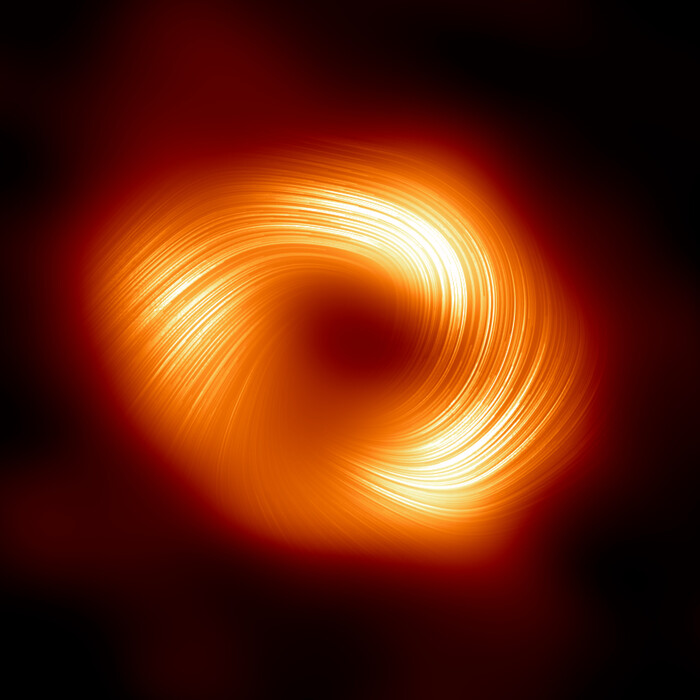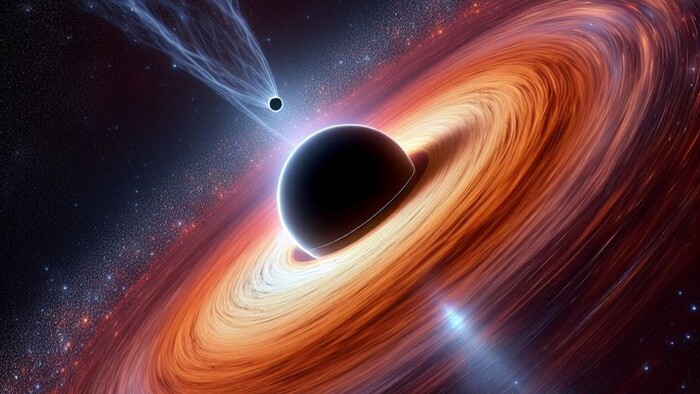If I begin by telling you that there is a place in the universe where a black hole is moving away from the center of its galaxy at a speed of 7.6 million kilometers per hour, or approximately 2,000 kilometers per second, surely more than one person would at least raise Eyebrows.
The supermassive black hole that we are going to talk about today has another peculiarity: it is not in the center of its galaxy.
In addition, the object in question has a mass several million times that of the Sun, it is much larger, a thousand times more, than Sagittarius A*, our black hole, which we have just taken a picture of.
Supermassive black holes in principle belong to the center of galaxies;
that's your place.
That's where they should be if nothing unusual happens.
Their presence is part of the mechanism by which galaxies grow.
Gravity pulls these massive structures made up of billions of stars, gas, and dark matter that are galaxies toward each other until they inevitably merge.
In the process, the supermassive black holes they contain also melt.
The galaxy becomes a larger one and the black hole remains in its heart.
Theoretical models of this process predict that it is possible that, in the merger event, the supermassive black hole will literally shoot out at speeds that can reach 5,000 km per second.
As a result, we would see the supermassive beast displaced from the gravitational center of the resulting galaxy.
And that, precisely, is what has been observed in the monstrous (because it is large, not because it is deformed) the protagonist of our story.
Quasar 3C 186 is not where it should be, in the center of the galaxy to which it belongs.
In fact, it is the most massive detected out of place.
A quasar is the most energetic footprint of a supermassive black hole.
It is very bright, often even brighter than the galaxy to which it belongs, and it gives off energy at the expense of the matter that the surrounding disk is feeding on.
The more matter it swallows, be it gas or stars, the brighter it shines.
Well, combining observations obtained with Hubble, Chandra, NOEMA and Sloan, it has been determined that 3C 186 is displaced about 24,000 light years from the center of its galaxy.
To put things in perspective, we are about 28,000 light years from the center of the Milky Way, in the case at hand it would be like having Sagittarius A* as a neighbor next door.
The energy required to move something as big as a supermassive black hole is enormous.
In this case it would be the equivalent of hundreds of millions of times the energy emitted in the most energetic events known, supernova explosions.
But it is not from supernovae where the energy comes from, but from the emission of gravitational waves.
For the merger of supermassive black holes to occur in the centers of the galaxies, first, the two objects are dragged to the center of the new galaxy, where they become a double binary system, which loses energy as one rotates around it. the other.
When they are close enough, which is to say that they have lost enough energy, they begin to emit gravitational waves until eventually the two black holes merge.
Gravitational waves are those disturbances in space-time that occur when two massive and compact objects collide.
The point is that, depending on the orientation of the spin axes of the merging black holes and their masses,
The discovery around quasar 3C186 is a perfect example of how the scientific method works.
According to Karl Popper, it is only possible to prove that a scientific theory is false, it cannot be proved that it is true.
Therefore, a range of experiments must be designed to verify that the explanation given for the range of unusual observations found for 3C186 is false, and they are working with new measurements of the phenomenon to achieve this.
We've already detected quite a few merger events for objects as dense as black holes, albeit only stellar-sized so far.
Until we have interferometers capable of detecting gravitational waves in space like LISA or radio antennas capable of detecting pulsar timing arrays, direct confirmation that supermassive black hole mergers really do occur at the center of galaxies we will have to make do with objects like 3C186 and its strange location.
The theory holds up for now, but stay tuned.
You can follow
MATERIA
on
,
and
, or sign up here to receive
our weekly newsletter
.







/cloudfront-eu-central-1.images.arcpublishing.com/prisa/2C5HI6YHNFHDLJSBNWHOIAS2AE.jpeg)



